HTIRC E-NEWSLETTER – May 2014
Volume 7 Issue 1
Articles in this issue:
- Forest and Wildlife Management and Research Field Day Offered Through HTIRC
- Fire Ecology of American Chestnut
- Update of Granulate Ambrosia beetle (Xylosandrus crassiusculus) Control Efforts
- Are Indiana Forests Prepared to Face New Climate Extremes?
- Remember Koa? We have Updates!
- HTIRC Cooperates with Purdue Extension to Provide Information on Deer Fence Construction
- HTIRC to Host International Forest Restoration Congress
- HTIRC Staff and Students Recognized for Achievements
- HTIRC and Related Websites Share the Latest Information
Welcome to this issue of the Hardwood Tree Improvement and Regeneration Center E-newsletter. The HTIRC is committed to enhancing the productivity and quality of Central Hardwood Region trees and forests for the economic and environmental benefits they provide. Scientists at the HTIRC are using conventional tree improvement breeding as well as molecular and genetic technologies to improve the wood quality, growth characteristics, and insect and disease resistance of trees like black walnut, black cherry, red and white oaks, butternut and American chestnut. Research in tissue culture, tree nursery practices, tree plantation establishment and management, and Central Hardwoods silvicultural systems is aimed at increasing the regeneration success rate for high quality hardwood trees and forests. Some interesting and unusual research areas include examining the potential for propagating trees with “figured” wood: birds-eye maple or curly walnut; and breeding trees that will be an economical source of bio-fuels. Twice per year we will attempt to provide interesting and useful information on Central Hardwood trees and forests, as well as sources for additional information and assistance. Please pass this newsletter along to others who may enjoy or benefit from the information provided. If you would like a closer look at the HTIRC, please visit our web site at: http://www.htirc.org
Forest and Wildlife Management and Research Field Day Offered through HTIRC
On May 31, 2014, the HTIRC, Purdue University Department of Forestry and Natural Resources and Purdue Extension will offer a free forest and wildlife management program and field tour at the Southeast Purdue Agricultural Center (SEPAC) near Butlerville, IN. This program will use the recent biomass harvesting experimental area created at SEPAC to demonstrate biomass and conventional timber harvesting techniques and study the impacts of those harvests on forest and wildlife resources over time.
The program is designed for landowners, but resource professionals interested in biomass harvesting are also welcome. There is no fee for the program, but advanced registration is required and attendance will be capped at 40 participants. A registration brochure and program details are available at https://ag.purdue.edu/fnr/Documents/SEPACFieldDay05_31_14.pdf
Fire Ecology of American Chestnut
Ethan Belair, M.S. Graduate Student
Mike Saunders,
Associate Professor, Ecology and Natural Resources
The American chestnut was an economically, ecologically and culturally important species in many eastern forests prior to the accidental importation of chestnut blight in the early 1900s. Blight has reduced chestnut to recurrent stump sprouts throughout its range, and HTIRC researchers are currently working to develop chestnut trees that will survive blight infection by interbreeding American chestnut with several Asian chestnut species. We hope that the next decade will see blight-resistant seedlings available in sufficient numbers to begin large-scale restoration efforts. However, limited understanding of chestnut silviculture and disturbance ecology presents a barrier to successful restoration. In early 2013, we began investigating how hybrid chestnut seedlings growing in understory environments respond to disturbance, and what adaptations help them deal with alterations of their environment. Understanding chestnut’s disturbance adaptations will aid the development of appropriate silvicultural guidelines for restoring the species when blight-resistant stock becomes available.
American chestnut historically grew in oak stands which were largely shaped by frequent fires. However, the method and timing of its establishment in those stands remains unclear, though it is sometimes assumed that chestnut, like oak, would respond well to frequent surface fires. Unfortunately, our observations of chestnut’s response to fire have been limited to mature individuals with large pre-existing rootstocks and can’t be used to infer the response of newly planted seedlings. To better understand chestnut’s fire ecology we have compared its specific disturbance adaptations to those of red oak by (1) comparing growth of seedlings in response to competition control, (2) excavating saplings to evaluate biomass allocation, crown structure and carbohydrate storage, and (3) topkilling individuals with a simulated prescribed burn and tracking sprouting response. Each of these projects investigates different aspects of potential fire adaptations.
The first study compared growth and survival of planted chestnut seedlings to red oak, sugar maple, and red maple, under treatments designed to isolate the effects of various sources of competition. Treatments included a midstory removal, trenching to reduce root competition, and weeding (using brushsaw and herbicide). After four years, chestnut was significantly taller in trenched plots (mean = 72in) compared to untrenched plots (50in), weeded plots (69in) compared to unweeded plots (51in) and in midstory removal plots (62in) versus full canopy (35in), and had outperformed the other species in most treatments. Red oak height increased in midstory removals (50in) relative to full canopy controls (37in), but did not respond to other treatments. Chestnut was the only species to respond to every treatment with significant growth increases, displaying a notable ability to capture available growing space. Its superior performance in the absence of canopy gaps suggests chestnut is better suited to the understory than previously thought, and suggests it may not be dependent on disturbances that create larger openings. However, chestnut benefitted from weeding, which reduced competition in a manner similar to surface fires.
The second study compared biomass partitioning, crown morphology and carbohydrate storage patterns in chestnut and red oak saplings. Specific morphological characteristics often arise in response to specific disturbance regimes. We found that chestnut invested much less in root mass (mean = 35% of total biomass) than red oak (44%), and had lower total carbohydrate reserves. Chestnut seedlings invested more in branches and foliage, and built highly efficient canopies that minimized self-shading. Red oak’s ability to capture light was hampered by their low investment in foliage and branches which led to narrow canopies and excessive self-shading. However, oak’s large carbohydrate reserves and root systems would have been beneficial on frequently disturbed sites. Our results suggest that chestnut is not as well adapted as oak to withstand frequent surface fire. However, chestnut’s highly efficient crown structure coupled with high growth potential indicates it may have functioned as an opportunist, establishing in the understory and awaiting the release afforded by gap formation. Red oak seedlings are better adapted to fire, but those adaptations impede their ability to acclimate to understory conditions.
Finally, the third study compared the response of chestnut and red oak following topkill by fire. Seedlings were topkilled using a small burn chamber and a plumber’s torch to simulate the physical effects of surface fire. Seedling’s sprout response was monitored throughout the growing season. Most seedlings of both species sprouted, with no discernible difference in number of sprouts per stump. Though oak responded more vigorously in terms of total biomass produced, there was little difference in the final size of the dominant sprouts (tallest sprout on each stump) produced by oak (34in) and chestnut (32in). This is likely more important in the long term than total biomass produced, and the advantages of a single 6ft sprout over several 1ft sprouts are obvious. Larger seedlings of both species produced more total biomass and taller individual sprouts, likely due to their more extensive root systems providing greater access to nutrient and water resources and larger carbohydrate reserves to fund initial sprout growth. Our results suggest that while oak might be slightly more productive than chestnut, both species can have highly productive sprout responses following topkill by fire. Our results indicate that well-established chestnut seedlings can produce sprouts above browse line and can be considered advance regeneration in the growing season following a single prescribed fire. Further studies are necessary to determine whether chestnut will tolerate the multiple burns that are sometimes used for understory management in oak forests.
To summarize, our investigation of American chestnut disturbance ecology shows that chestnut 1) benefits from the opportunity to become established in low-competition environments prior to disturbance, 2) is well-adapted to prolonged periods in low-light conditions, 3) has the necessary adaptations to withstand at least one surface fire, but 4) is likely not a resilient as red oak to repeated disturbances. These findings have important implications for chestnut restoration efforts, and our results provide a positive outlook for future attempts at landscape-scale restoration of American chestnut under intact forest canopies. It seems that understory chestnut regeneration will tolerate prescribed fire if it has sufficient time to establish large root reserves, though it remains uncertain how chestnut might respond to multiple surface fires. The benefit of surface fire to control undesirable species is well recognized, and the time required for chestnut to establish large root reserves may be minimized by using a midstory removal which can increase survival and growth of underplanted seedlings. Restoration may be more successful where midstory removal, burning, or other forms of early stand management provide chestnut a brief period of reduced competition. When combined with a multi-stage shelterwood, this may constitute a viable restoration strategy for chestnut in many of the eastern oak-hickory forests where it was originally dominant.
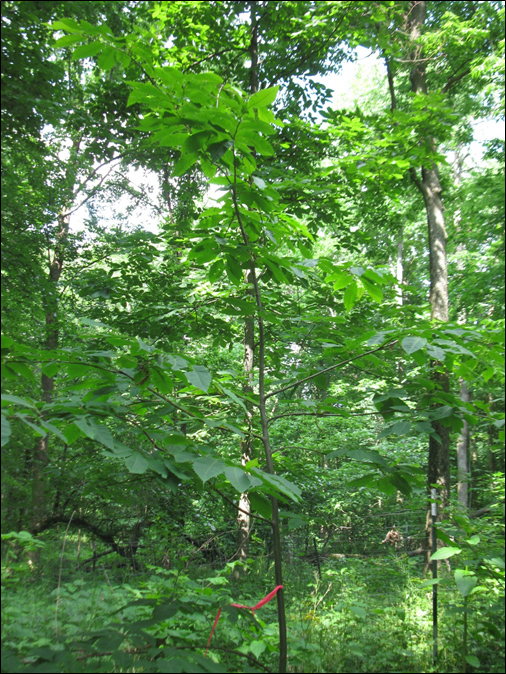
Figure 1. This American chestnut sapling stands just over 17 feet tall after 4 years in the understory. This fast growth is due in part to its wide crown which efficiently captures all available light and minimizes self-shading.
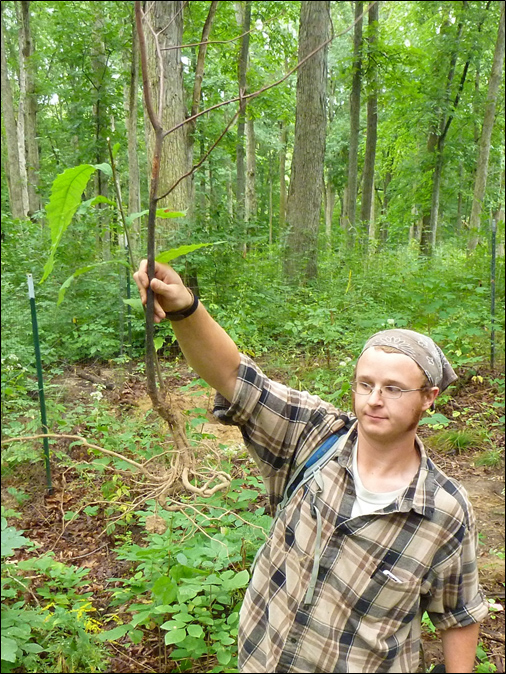
Figure 2. This American chestnut seedling was slightly smaller than average, and due to its small root system, it was unable to produce more than one small sprout (to the left of the dead stem) following surface fire topkill.

Figure 3. This oak sprout benefitted from the original seedling’s large root system and ample carbohydrate reserves (original seedling was 7.5 ft tall and 1.5 inches dbh). This sprout is more than 9 feet tall just 3 months following surface fire topkill, and is already taller than the surrounding vegetation. Long-term, its chances of canopy recruitment are much better than smaller, less vigorous sprouts.
Update of Granulate Ambrosia beetle (Xylosandrus crassiusculus) Control Efforts
By Nikki VanDerLaan, MS
Native to Asia, exotic wood-boring ambrosia beetles vector pathogenic, wood-staining fungi and are a threat to managed and natural forest systems (Oliver and Mannion 2001). These invasive pests are accidentally transported in wood packing material and are commonly found at ports-of-entry around the United States (Haack 2001). The symbiotic fungi associated with these beetles is capable of killing valuable trees and significantly reducing their commercial value (Cote 2008).
Two species that are of concern to the Central Hardwood Region include the black stem borer, Xylosandrus germanus, (Fig.1) and the granulate ambrosia beetle, Xylosandrus crassiusculus (Fig.2). Both beetles have over 200 host tree and shrub species, including valuable hardwoods such as chestnut, black cherry, black walnut, butternut, hickory and oak (Cote 2008). The ambrosia beetles range from a dark to reddish brown in color and are approximately 1/10” of an inch long making them nearly impossible to distinguish between species with the naked eye (Cote 2008).
Both species have two generations per year in Indiana and have one flight period in early spring (when temperatures remain above 70°F) and another in late June-early July (Cote 2008). During the beginning of their flight period, females emerge from galleries in search of a new host. Once a suitable host has been located, females construct egg galleries by boring directing into the sapwood of trees. Females then introduce symbiotic fungi into the gallery carried within pockets under their head (Cote 2008). Both adults and larvae feed on the fungi and not the host itself rendering the use of conventional insecticides useless. The fungi spread throughout the water column preventing water and nutrients from reaching the crown, thus girdling the tree and staining the wood blue (Fig.3) (Cote 2008).
Initial signs of an ambrosia beetle infestation include entrance holes 1/10” inch in diameter in the bark, projections of long toothpick-like structures from entrance holes made of residual sawdust (Fig.4), epicormic shoots, flagging of the leaves, and crown dieback (Cote 2008). Ambrosia beetles locate hosts by use of odors given off by trees. There has not been a pheromone identified for either ambrosia beetle species (Hulcr and Cognato 2010). However, exploitation of host odors such as ethanol, a common stressed tree odor, and conophthorin, a common decidious tree odor, appear to be an effective means of detection and control when used in combination (VanDerLaan and Ginzel 2013). Yet, the best possible way to control ambrosia beetle infestations is prevention by maintaining good silviculture practices, i.e. watering, picking up fallen branches, and pruning trees in the fall instead of the spring (Cote 2008).
Cote, K.W. (2008) Granulate Ambrosia Beetle (Xylosandrus crassiusculus) [WWW document]. URL http://www.in.gov/dnr/entomolo/files/ep-GranulateAmbrosiaBeetleFactsheet.pdf
Haack, R.A. (2001) Intercepted Scolytidae (Coleoptera) at U.S. ports of entry: 1985–2000. Integrated Pest Management Review, 6, 253–282
Hulcr, J. & Cognato, A.I. (2010) Repeated evolution of crop theft in fungus-farming beetles. Evolution, 64, 3205–3212.
Oliver, J.B. & Mannion, C.M. (2001) Ambrosia beetles (Coleptera: Scolytidae) species attacking chestnut and captured in ethanol-baited traps in middle Tennessee. Environmental Entomology, 30, 909–918.
VanDerLaan, N. R., and M. D. Ginzel. 2013. “Enhanced monitoring efficacy for Xylosandrus crassiusculus (Coleoptera: Curculionidae: Scolytinae) using conophthorin with ethanol-baited lures.” Agriculture and Forest Entomology. 15(4): 391-397.
Matt Ginzel recently provided a webinar on using semiochemicals to detect and monitor invasive ambrosia beetle in hardwood forests presented through the Emerald Ash Borer University program

Figure 1. The black stem borer, Xylosandrus germanus. Photo courtesy of J.R. Baker and S.B. Bambara, North Carolina State University, Bugwood.org.
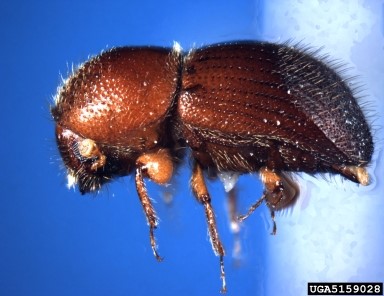
Figure 2. The granulate ambrosia beetle, Xylosandrus crassiusculus. Photo courtesy of J.R. Baker and S.B. Bambara, North Carolina State University, Bugwood.org.

Figure 3. Ambrosia beetle galleries and blue-staining fungi. Photo courtesy of G. Keith Douce, University of Georgia, Bugwood.org.
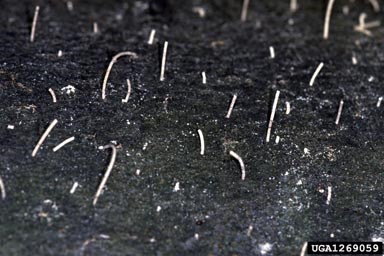
Figure 4. Toothpick-like structures protruding from the bark, an initial sign of an ambrosia beetle infestation. Photo courtesy of Beat Forester, Swiss Federal Institute of Forest, Snow and Landscape Research, Bugwood.org.
By Shaneka Lawson, Plant Physiologist
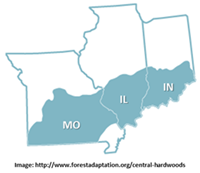
In reports published online in March and April of this month, vulnerabilities within our Central Hardwood forests were identified. Our Central Hardwoods region (CHR) stretches from the Missouri Ozarks to Southernmost points of Illinois and Indiana. USDA Forest Service reports have stated that this summer could bring higher temperatures combined with an increase in extended drought periods. Data records from the last 30 years have indicated a higher number of 3 inch or greater summer precipitation events and fewer rain showers in the CHR, conditions that can increase erosion. These severe weather events in combination with the prevalence of invasive species are destined to negatively impact CHR forests.
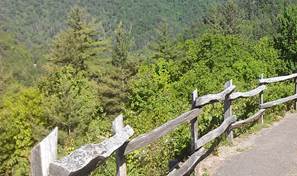 The reports go on to state that climatic changes will allow for the expansion of southern forest tree species such a shortleaf pine (Pinus echinata) northward to coincide and potentially outcompete native northern species such as American beech (Fagus grandifolia), sugar maple (Acer saccharum), and white ash (Fraxinus americana). Intrusion of shortleaf pine can also lead to increased forest fragmentation and a lack of native species establishment. Those species more tolerant to fire such as oak (Quercus spp.), shagbark hickory (Carya ovata), and many pines (Pinus spp.) could have competitive advantages as higher temperatures increase predicted fire incidences.
The reports go on to state that climatic changes will allow for the expansion of southern forest tree species such a shortleaf pine (Pinus echinata) northward to coincide and potentially outcompete native northern species such as American beech (Fagus grandifolia), sugar maple (Acer saccharum), and white ash (Fraxinus americana). Intrusion of shortleaf pine can also lead to increased forest fragmentation and a lack of native species establishment. Those species more tolerant to fire such as oak (Quercus spp.), shagbark hickory (Carya ovata), and many pines (Pinus spp.) could have competitive advantages as higher temperatures increase predicted fire incidences.
Several notions pertaining to CHR and forests located in the Northern United States were highlighted such as the dramatic lack of age-class diversity. Eight percent of forests are young (≤20 years old), roughly 60% are old-growth (between 40−80 years old), and 5% are very-old growth (≥100 years old). Secondly, urban sprawl has impacted forest cover as greater than 27 million people are expected to join the population and absorb nearly 5 million hectares of currently forested land. A final concern was management intensity. The presented data indicated that Northern forests are not intensively managed and therefore managers are unlikely to be able to financially support other restoration activities or aggressively attempt to combat disease or invasive species pervasiveness. Several potential solutions were proposed including the creation and implementation of goals for forest diversity on the regional and state level and the development of more mutually beneficial relationships between land owners, forest managers, industry professionals and the general public to revitalize and support reforestation efforts to neutralize losses to urban expansion.
Complete data reports were published by the U.S. Forest Service’s Northern Research Station and can be found online at: http://www.nrs.fs.fed.us/pubs/45430 and http://www.nrs.fs.fed.us/pubs/45716.
Remember Koa? We have Updates!
By Shaneka Lawson, Plant Physiologist
In the initial articles about the work of the Tropical HTIRC, Acacia koa (koa), the current species of interest for the Research Center, was described. Koa is a tree species endemic to the all islands within the Hawaiian archipelago but only exists in populations of sufficient size to be called forests on Hawai’i, Kauai, Maui and Oahu. The prevalence of cattle-grazing, invasives, and climatic events have had a tremendous effect on koa populations and several small-scale restoration efforts have failed to slow forest fragmentation and decline.
Currently, efforts are underway to genetically determine which trees will have a greater chance of survival at various locations on Hawai’i while still seedlings, thus maximizing the effectiveness of restoration efforts. This would also initiate the creation of more environmental stress-resistant trees at a particular site. Because little information exists regarding koa genetics, the Tropical HTIRC seeks to identify genes or a subset of genes responsible for environmental adaptation along precipitation and elevation gradients. Attributes of the genetic code that provide certain trees with resistance to environmental and biological factors while others are susceptible, will be identified in an effort to detect the genes involved.
Nineteen sites and more than 300 trees have been selected and many will be submitted for Next Generation Sequencing (Illumina®) analysis. This research will generate a koa seed source map that can be used by landowners and researchers alike to facilitate artificial forest regeneration by matching genetic fitness of seedlings to selected local sites.
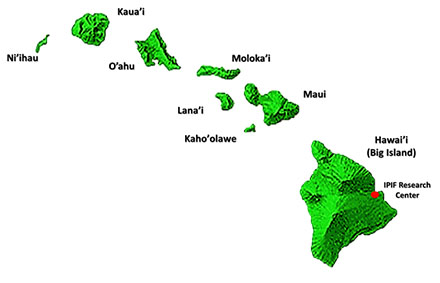

HTIRC Cooperates with Purdue Extension
to Provide Information on Deer Fence Construction
HTIRC has been building plastic mesh deer exclusion fence to protect tree seedling plantings for several years, and has initiated experiments to determine the impact of fencing on seedling performance and survival. Results after five years of measurements confirm the benefits of deer fencing for increased growth and improved survival of seedlings across many planting sites in Indiana and the Central Hardwood Region.
Land managers and owners struggling to grow their fine hardwood seedlings in the presence of persistent deer browsing and antler damage may be interested in options to protect seedlings and improve planting outcomes. To that end, we have produced a Purdue Extension publication that outlines the steps to build a plastic mesh deer exclusion fence. We have found this fence to be an effective and economical way to protect seedlings from deer during the first 6 to 8 years of growth. If you are planting or naturally regenerating areas of ½ acre or more and anticipate deer damage, you may want to consider this fencing option.
The publication How to Build a Plastic Mesh Deer Exclusion Fence can be accessed at:
https://www.extension.purdue.edu/extmedia/FNR/FNR-486-W.pdf

Black Walnut, black cherry, red oak and white oak seedlings three seasons after planting, protected by plastic mesh deer fence on the left and no protection from deer browsing on the right.
HTIRC to Host International Forest Restoration Congress
The 2nd Restoring Forests Congress – Restoring Forests: What Constitutes Success in the 21st Century? will be held in Lafayette, Indiana October 14-16, 2014.
This International Union of Forest Research Organizations (IUFRO) symposium will continue to communicate advances in the themes of forest restoration techniques and theory from the 2011 Congress. Yet, will also explore what constitutes restoration in the 21st Century by redefining the scope of forest restoration and narrowing the vision of restoration success in relation to a realistic, achievable end result.
The conference comprises oral presentations, as well as a field excursion. The oral presentation sessions include keynote speakers and voluntary presentations of papers with time designated for discussions. The field tours will include research sites of the Hardwood Tree Improvement & Regeneration Center and Purdue University Department of Natural Resources near Lafayette, Indiana. Topics will include research on fine hardwoods including black walnut, cherry, and red and white oak.
For additional information on program and registration details visit:
https://www.purdue.edu/fnrrf/wp-content/uploads/2014/05/RestoringForestsCircular2.pdf
HTIRC Staff and Students Recognized for Achievements
Janis Gosewehr was recognized as the Outstanding Clerical/Service Staff member in the Purdue University Department of Forestry and Natural Resources for 2014.
Ethan Belair received second place at the Purdue University Forestry and Natural Resources Research Symposium 2014 in the category M.S. – Research.
Johanna Desprez received Honorable Mention at the Purdue University Forestry and Natural Resources Research Symposium 2014 in the category M.S. – Research.
Carmen Dobbs tied for first place at the Purdue University Forestry and Natural Resources Research Symposium 2014 in the category Undergraduate Research.
Bradley Graham was awarded the 2014Charles H. Michler Scholarship for the Outstanding Graduate Student Researcher in Forest Biology.
HTIRC and Related Websites Share the Latest Information
HTIRC shares informative articles and publications on a few different websites that can be useful to landowners and scientists alike. On the HTIRC website, you can find back issues of this e-newsletter since 2007. Other popular choices are the publications pages, one for research, and a second for landowners. The research page has journal articles published by HTIRC scientists and students. The landowner’s page has guidance for hardwood plantation and natural stand management. Currently, the most popular publications produced by the HTIRC are:
- Identification of Butternuts and Butternut Hybrids, was the top HTIRC downloaded publication in 2013 with over 6000 downloads.
- Native Hardwood Trees of the Central Hardwood Region, 3600+ downloads
- Diseases in Hardwood Tree Plantings, 3500+ downloads
- Conservation and Management of Butternut Trees, 2100+ downloads
- Fertilizing, Pruning, and Thinning Hardwood Plantations, 1500+ downloads
HTIRC hosts national TCD website
The national thousand cankers disease website, at www.thousandcankers.com, is hosted and updated at the HTIRC in partnership with the US Forest Service Northeastern Area State and Private Forestry and the US Forest Service Northern Research Station. Last year, the website averaged approximately 550 visitors a month, with a 2013 Total of 6541 visitors and 16,500 page views. Most visitors scan the main page, the news section, and their state information page for updates. The FAQ page is also popular at about 50 new views a month.
Also on the site is a 3-part TCD webinar series which aired in spring 2013. That series had around 300 views per month while the webinars were being recorded, and still consistently receives 10-20 new viewers per month.
Additional forestry information
HTIRC publications are also posted on our partner, Purdue Department of Forestry & Natural Resources, extension website. Popular publications include topics on all types of forestry and natural resources issues, including management. If your interests lie specifically with forest management, many different resources and links are organized together on the “Forests and Trees” area of the extension website.
HTIRC information and publications can also be found at the US Forest Service Northern Research Station HTIRC website. HTIRC is a unit of the Northern Research Station, which partners with Purdue University and many other organizations, agencies, companies, and individuals to make this research center possible.
Have questions about tree planting? This series of publications can be viewed or downloaded free of charge. Planting and Care of Fine Hardwood Seedlings
van Eck Scholarships available for graduate research with the HTIRC.
Ask the HTIRC: email Lenny Farlee with your tree planting and forest management questions and we’ll help you find the answers.
